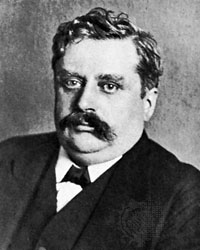- Alfred Werner
Infobox_Scientist
name = Alfred Werner
image_size=180px
birth_date =December 12 ,1866
birth_place =Mulhouse ,Alsace
nationality =Switzerland
death_date = death date and age| 1919|11|15|1866|12|12
death_place =
field =Inorganic chemistry
work_institution =University of Zurich
alma_mater =University of Zurich
doctoral_advisor =Arthur Rudolf Hantzsch ,Marcellin Berthelot
doctoral_students =
known_for = configuration oftransition metal complexes
prizes =Nobel Prize for Chemistry (1913)Alfred Werner (
December 12 ,1866 -November 15 ,1919 ) was a Swiss chemist who was a professor at theUniversity of Zurich . He won theNobel Prize in Chemistry in 1913 for proposing the octahedral configuration oftransition metal complexes. Werner developed the basis for moderncoordination chemistry . He was the first inorganic chemist to win the Nobel prize, and the only one prior to 1973.Biography
Werner was born in 1866 in
Mulhouse ,Alsace (which was then part ofFrance , but which was annexed byGermany in 1871). He went to Switzerland to study chemistry atZurich where he obtained hisdoctorate in 1890. After postdoctoral study inParis , he returned to Zurich to teach in 1892, and became a professor as well a Swiss citizen in 1895.Research
Coordination chemistry
In 1893, Werner was the first to propose correct structures for coordination compounds containing complex ions, in which a central transition metal atom is surrounded by neutral or anionic
ligands .For example, it was known that cobalt forms a "complex" with formula CoCl3•6NH3, but the nature of the association indicated by the dot was mysterious. Werner proposed the structure [Cobalt(III) hexammine chloride|
[ Co(NH3)6] Cl3] , with the Co3+ ion surrounded by six NH3 at the vertices of an octahedron. The three Cl- are dissociated as free ions, which Werner confirmed by measuring theelectrical conductivity of the compound in aqueous solution, and also by chloride anion analysis using precipitation withsilver nitrate . Later,magnetic susceptibility analysis was also used to confirm Werner's proposal for the chemical nature of CoCl3•6NH3.For complexes with more than one type of ligand, Werner succeeded in explaining the number of
isomers observed. For example, he explained the existence of two isomers of "Co(NH3)4Cl3", one green and one purple. Werner proposed that these are two geometric isomers of formula [Co(NH3)4Cl2] Cl, with one Cl- ion dissociated as confirmed by conductivity measurements. The Co atom is surrounded by four NH3 and two Cl ligands at the vertices of an octahedron. The green isomer is "trans" with the two Cl ligands at opposite vertices, and the purple is "cis" with the two Cl at adjacent vertices.Werner also prepared complexes with
optical isomers , and in 1914 he reported the first synthetic chiral compound lacking carbon, known ashexol with formula [Co(Co(NH3)4(OH)2)3] Br6.Nature of valence
Before Werner, chemists defined the valence of an element as the number of its bonds without distinguishing different types of bond. However in complexes such as [Co(NH3)6] Cl3 for example, Werner considered that the Co-Cl bonds correspond to a "primary" valence of 3 at long distance, while the Co-NH3 bonds which correspond to a "secondary" or weaker valence of 6 at shorter distance. This secondary valence of 6 he referred to as the
coordination number which he defined as the number of molecules (here of NH3) directly linked to the central metal atom. In other complexes he found coordination numbers of 4 or 8.On these views, and other similar views, in 1904
Richard Abegg formulated what is now known asAbegg's rule which states that that the difference between the maximum positive and negative valence of an element is frequently eight. This rule was used later in 1916 whenGilbert N. Lewis formulated the “octet rule ” in hiscubical atom theory.Today Werner's primary valence corresponds to the oxidation state, and the secondary valence is always called coordination number. The Co-Cl bonds (in the above example) are now classed as ionic, and each Co-N bond is a
coordinate covalent bond between theLewis acid Co3+ and theLewis base NH3.References
*cite journal | title= Alfred Werner's Inorganic Counterparts of Racemic and Mesomeric Tartaric Acid: A Milestone Revisited | author=W. Gregory Jackson, Josephine A. McKeon, Silvia Cortez | journal=
Inorg. Chem. | volume=43 | issue=20 | pages=6249–6254 | year=2004 | url= | doi=10.1021/ic040042e
*cite journal | title= Alfred Werner Revisited: The Coordination Chemistry of Anions | author=Kristin Bowman-James | journal=Acc. Chem. Res. | volume=38 | issue=8 | pages=671–678 | year=2005 | url= | doi=10.1021/ar040071t S0001-4842(04)00071-8External links
* [http://nobelprize.org/chemistry/laureates/1913/werner-bio.html Biography at Nobelprize.org]
* [http://www.angelfire.com/ms3/my-page/www/press-werner.html The Nobel Prize in Chemistry 1913] - short article about his work on the linkage of atoms in molecules by which he has thrown new light on earlier investigations and opened up new fields of research especially in inorganic chemistry.
* [http://www.angelfire.com/ultra2/ghbdtn/2/werner-bio.html Alfred Werner – Biography] .
Wikimedia Foundation. 2010.
